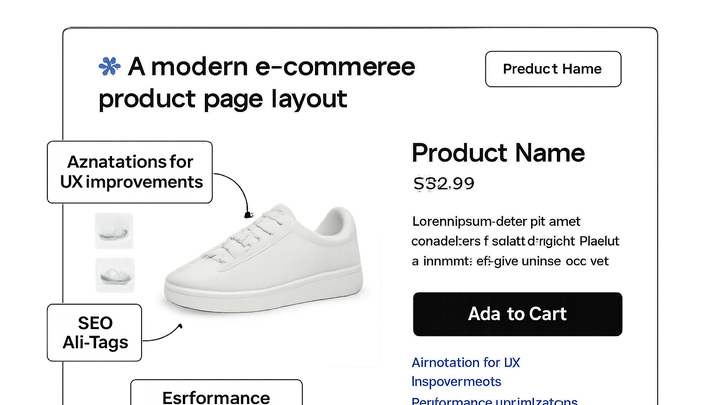Published on 2025-06-29T21:11:47Z
What is Product Page Imagery? Examples for CRO, UX & SEO
Product Page Imagery refers to the selection, design, and presentation of visual assets on an e-commerce product page to showcase a product’s features, build trust, and drive conversions. High-quality photography, multiple angles, lifestyle shots, and contextual backgrounds all contribute to a more engaging shopping experience. Well-optimized imagery not only improves user engagement (UX) but also boosts page load speeds (CRO) and enhances discoverability via image SEO. Tools like prevue.me can audit your product images for composition, accessibility (alt text, color contrast), performance (compression, responsive breakpoints), and SEO (file naming, structured data), delivering actionable critiques prioritized for lead generation and conversion uplift.
Key elements include:
- High resolution and multiple angles
- Contextual or lifestyle usage
- Accessibility (alt text, ARIA labels)
- Performance optimization (compression, lazy loading)
- SEO best practices (file names, captions, structured data)
Product page imagery
Visual assets on product pages that drive conversions by enhancing UX, SEO, accessibility, and performance.
Why Product Page Imagery Matters
Imagery is often the first thing a shopper notices. It shapes perceptions of quality, conveys product details more effectively than text alone, and can dramatically impact conversion rates. From a UX standpoint, clear and descriptive visuals reduce cognitive load and help customers make confident purchase decisions. On the SEO side, properly tagged and optimized images can drive organic traffic through image search and improve overall page rankings.
-
Visual appeal & engagement
High-quality, professionally shot images capture attention and encourage users to stay on the page longer, increasing the likelihood of conversion.
- Multiple angles:
Show the product from front, side, back, and close-up shots to give a comprehensive view.
- Lifestyle context:
Place the product in real-world scenarios to help customers imagine its use.
- Multiple angles:
-
Trust & credibility
Detailed, accurate imagery reduces returns by setting clear expectations and builds brand trust.
- Scale & proportion:
Include objects or measurements to convey true size.
- Consistency:
Maintain a uniform background and lighting style across all images.
- Scale & proportion:
-
Seo & accessibility benefits
Optimized images with descriptive alt text and file names improve discoverability and ensure compliance with accessibility standards.
- Alt text:
Write clear, concise descriptions with relevant keywords for screen readers and image search.
- Structured data:
Implement schema.org/Product with
imageproperty for rich search results.
- Alt text:
Best Practices for Optimization
Balancing image quality with performance and SEO is crucial. Follow industry best practices to ensure fast load times, high engagement, and maximum search visibility.
-
File format & compression
Choose modern formats (WebP, AVIF) and apply lossless or controlled lossy compression to reduce file size without sacrificing clarity.
- Automated compression:
Use tools like prevue.me to analyze file size and suggest optimal compression levels.
- Fallback formats:
Provide JPEG/PNG fallbacks for browsers that don’t support newer formats.
- Automated compression:
-
Responsive & lazy loading
Serve appropriately sized images for different viewports and defer off-screen images to speed up initial render.
- Srcset & sizes:
Define multiple image sources for various screen widths.
- Intersection observer:
Implement native lazy-loading or JavaScript libraries for progressive loading.
- Srcset & sizes:
-
Seo-friendly attributes
Optimize file names, alt attributes, captions, and include images in XML sitemaps to maximize visibility.
- Descriptive filenames:
Use keyword-rich, hyphenated file names like
black-leather-jacket-front.jpg. - Image sitemaps:
List all product images in your sitemap to help crawlers find them.
- Descriptive filenames:
Common Pitfalls & How to Avoid Them
Many e-commerce sites struggle with slow load times, inconsistent imagery, and missing accessibility tags. Identifying and addressing these issues can significantly improve both UX and SEO.
-
Overcompression artifacts
Excessive compression can introduce blurriness or pixelation, undermining perceived quality.
- Quality checks:
Review images at 100% zoom before publishing.
- Quality checks:
-
Missing alt text
Skipping alt text hurts both accessibility and image SEO.
- Audit & fill gaps:
Use prevue.me to scan for images without alt attributes and suggest descriptive text.
- Audit & fill gaps:
-
Ignoring mobile users
Large desktop images without responsive handling lead to slow page loads and poor mobile UX.
- Mobile-first testing:
Simulate slower connections and smaller viewports to ensure images load quickly.
- Mobile-first testing:
How prevue.me Enhances Product Page Imagery
prevue.me offers automated, prioritized critiques of your product images to boost CRO, UX, SEO, and accessibility. Integrate the tool into your workflow to identify issues, track improvements, and measure impact on lead generation.
-
Actionable critique reports
Receive detailed feedback on composition, alt text, file size, and responsiveness, ranked by potential impact on conversions.
-
Accessibility & seo audits
Automatically detect missing alt attributes, poor color contrast, and suboptimal file naming for improved compliance and discoverability.
-
Performance monitoring
Track image load times, lazy-loading adoption, and compression efficiency over time, ensuring fast page renders.
-
Integration & workflow
Seamlessly integrate with your CMS or build pipeline to enforce image best practices before deployment.
